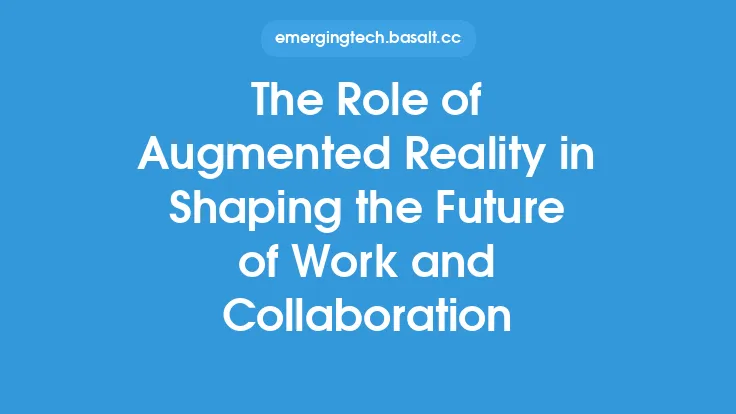The concept of spatial computing has been gaining significant attention in recent years, and its potential to revolutionize the way we interact with technology is vast. At its core, spatial computing refers to the ability of computers to understand and interact with the physical world in a more human-like way. This is achieved through the use of various sensors, cameras, and other technologies that allow computers to perceive and interpret their surroundings. As a result, spatial computing has the potential to enable new forms of interaction that are more natural, intuitive, and immersive.
Introduction to Spatial Computing
Spatial computing is a multidisciplinary field that combines concepts from computer science, engineering, and cognitive psychology to create a new paradigm for human-computer interaction. It involves the use of various technologies such as computer vision, machine learning, and sensor fusion to enable computers to understand and interact with their environment. This can include tasks such as object recognition, tracking, and manipulation, as well as more complex tasks such as scene understanding and activity recognition. By enabling computers to understand and interact with the physical world, spatial computing has the potential to revolutionize a wide range of applications, from gaming and entertainment to education and healthcare.
Key Technologies Enabling Spatial Computing
Several key technologies are enabling the development of spatial computing, including computer vision, machine learning, and sensor fusion. Computer vision refers to the ability of computers to interpret and understand visual data from the world, such as images and videos. This can be used to enable tasks such as object recognition, tracking, and scene understanding. Machine learning is a type of artificial intelligence that enables computers to learn from data and improve their performance over time. This can be used to enable tasks such as activity recognition and prediction. Sensor fusion refers to the ability of computers to combine data from multiple sensors, such as cameras, microphones, and accelerometers, to create a more complete understanding of the world.
Spatial Computing and Human-Computer Interaction
Spatial computing has the potential to revolutionize human-computer interaction by enabling new forms of interaction that are more natural, intuitive, and immersive. For example, spatial computing can be used to enable gesture-based interaction, where users can control computers using hand or body gestures. It can also be used to enable voice-based interaction, where users can control computers using voice commands. Additionally, spatial computing can be used to enable augmented reality (AR) and virtual reality (VR) experiences, where users can interact with virtual objects and environments in a more immersive and interactive way.
Applications of Spatial Computing
The applications of spatial computing are vast and varied, and include fields such as gaming, education, healthcare, and entertainment. For example, spatial computing can be used to create more immersive and interactive gaming experiences, where players can use gesture-based interaction to control characters and objects. It can also be used to create more interactive and engaging educational experiences, where students can use spatial computing to explore and interact with virtual objects and environments. In healthcare, spatial computing can be used to enable more effective and efficient patient care, such as remote monitoring and telemedicine.
Technical Challenges and Limitations
Despite the potential of spatial computing, there are several technical challenges and limitations that must be addressed. For example, spatial computing requires significant computational resources and data storage, which can be a challenge for devices with limited processing power and memory. Additionally, spatial computing requires high-quality sensors and cameras, which can be expensive and difficult to integrate into devices. Furthermore, spatial computing raises several privacy and security concerns, such as the potential for unauthorized access to sensitive data and the potential for biased or discriminatory algorithms.
Future Directions and Opportunities
Despite the challenges and limitations, the future of spatial computing is bright, with several exciting opportunities and directions on the horizon. For example, the development of new technologies such as 5G networks and edge computing is expected to enable more widespread adoption of spatial computing, particularly in fields such as gaming and entertainment. Additionally, the development of new applications such as smart homes and cities is expected to drive demand for spatial computing, particularly in fields such as healthcare and education. Furthermore, the development of new technologies such as brain-computer interfaces and neural networks is expected to enable more advanced and sophisticated forms of spatial computing, particularly in fields such as gaming and education.
Conclusion
In conclusion, spatial computing has the potential to revolutionize the way we interact with technology, enabling new forms of interaction that are more natural, intuitive, and immersive. While there are several technical challenges and limitations that must be addressed, the future of spatial computing is bright, with several exciting opportunities and directions on the horizon. As the field continues to evolve and mature, we can expect to see more widespread adoption of spatial computing, particularly in fields such as gaming, education, and healthcare. Ultimately, the potential of spatial computing to shape the future of interaction is vast, and its impact is expected to be felt across a wide range of industries and applications.





